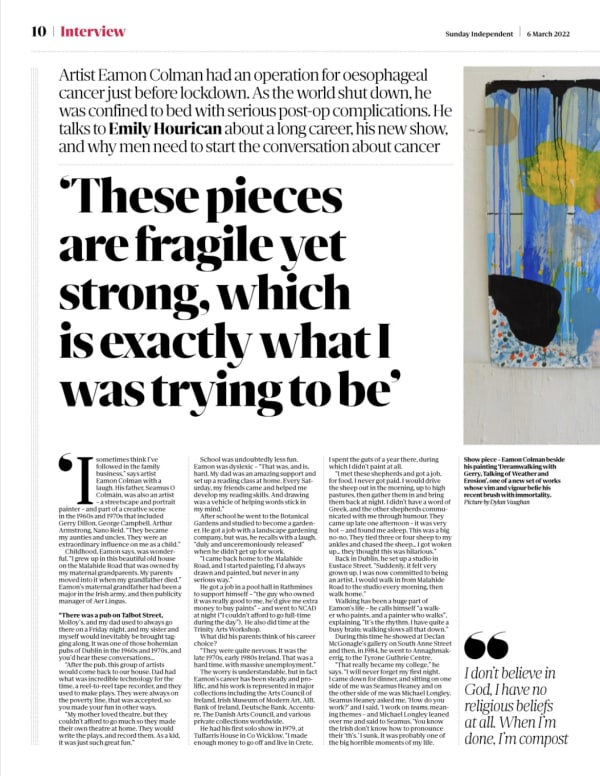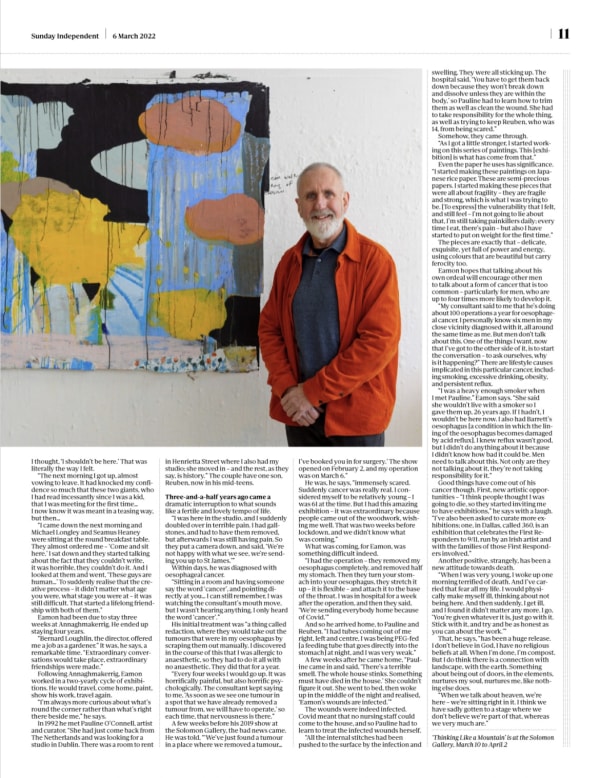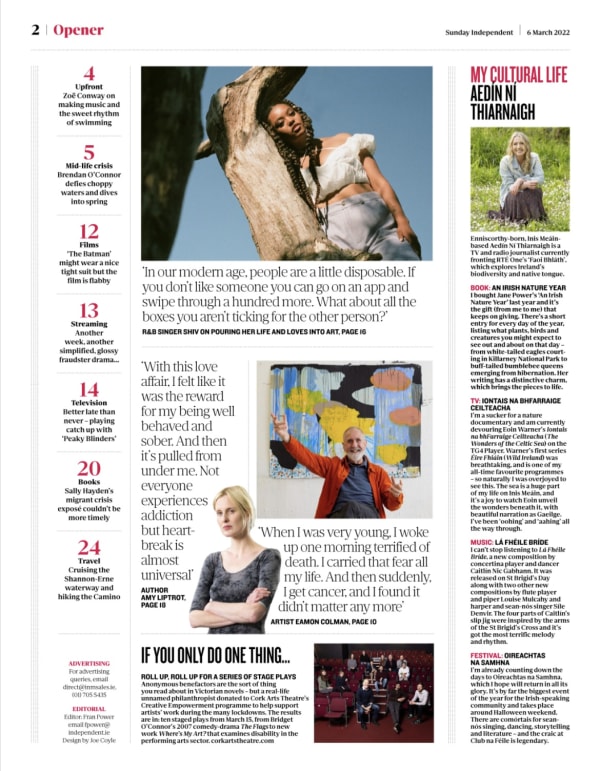'These pieces are fragile yet strong, which is exactly what I was trying to be'
Artist Eamon Colman had an operation for oesophageal cancer just before lockdown. As the world shut down, he was confined to bed with serious post-op complications. He talks to Emily Hourican about a long career, his new show, and why men need to start the conversation about cancer
'I sometimes think I've followed in the family business,” says artist Eamon Colman with a laugh. His father, Seamus O Colmáin, was also an artist - a streetscape and portrait painter - and part of a creative scene in the 1960s and 1970s that included Gerry Dillon, George Campbell, Arthur Armstrong, Nano Reid. "They became my aunties and uncles. They were an extraordinary influence on me as a child.”
Childhood, Eamon says, was wonderful. "I grew up in this beautiful old house on the Malahide Road that was owned by my maternal grandparents. My parents moved into it when my grandfather died.” Eamon's maternal grandfather had been a major in the Irish army, and then publicity manager of Aer Lingus.
"There was a pub on Talbot Street, Molloy's, and my dad used to always go there on a Friday night, and my sister and myself would inevitably be brought tagging along. It was one of those bohemian pubs of Dublin in the 1960s and 1970s, and you'd hear these conversations...
"After the pub, this group of artists would come back to our house. Dad had what was incredible technology for the time, a reel-to-reel tape recorder, and they used to make plays. They were always on the poverty line, that was accepted, so you made your fun in other ways.
"My mother loved theatre, but they couldn't afford to go much so they made their own theatre at home. They would write the plays, and record them. As a kid, it was just such great fun.”
School was undoubtedly less fun. Eamon was dyslexic - "That was, and is, hard. My dad was an amazing support and set up a reading class at home. Every Saturday, my friends came and helped me develop my reading skills. And drawing was a vehicle of helping words stick in my mind.”
After school he went to the Botanical Gardens and studied to become a gardener. He got a job with a landscape gardening company, but was, he recalls with a laugh, "duly and unceremoniously released” when he didn't get up for work.
"I came back home to the Malahide Road, and I started painting. I'd always drawn and painted, but never in any serious way.”
He got a job in a pool hall in Rathmines to support himself - "the guy who owned it was really good to me, he'd give me extra money to buy paints” - and went to NCAD at night ("I couldn't afford to go full-time during the day”). He also did time at the Trinity Arts Workshop.
What did his parents think of his career choice?
"They were quite nervous. It was the late 1970s, early 1980s Ireland. That was a hard time, with massive unemployment.”
The worry is understandable, but in fact Eamon's career has been steady and prolific, and his work is represented in major collections including the Arts Council of Ireland, Irish Museum of Modern Art, AIB, Bank of Ireland, Deutsche Bank, Accenture, The Danish Arts Council, and various private collections worldwide.
He had his first solo show in 1979, at Tulfarris House in Co Wicklow. "I made enough money to go off and live in Crete. I spent the guts of a year there, during which I didn't paint at all.
"I met these shepherds and got a job, for food. I never got paid. I would drive the sheep out in the morning, up to high pastures, then gather them in and bring them back at night. I didn't have a word of Greek, and the other shepherds communicated with me through humour. They came up late one afternoon - it was very hot — and found me asleep. This was a big no-no. They tied three or four sheep to my ankles and chased the sheep… I got woken up… they thought this was hilarious.”
Back in Dublin, he set up a studio in Eustace Street. "Suddenly, it felt very grown up. I was now committed to being an artist. I would walk in from Malahide Road to the studio every morning, then walk home.”
Walking has been a huge part of Eamon's life - he calls himself "a walker who paints, and a painter who walks”, explaining, "It's the rhythm. I have quite a busy brain; walking slows all that down.”
During this time he showed at Declan McGonagle's gallery on South Anne Street and then, in 1984, he went to Annaghmakerrig, to the Tyrone Guthrie Centre.
"That really became my college,” he says. "I will never forget my first night. I came down for dinner, and sitting on one side of me was Seamus Heaney and on the other side of me was Michael Longley. Seamus Heaney asked me, 'How do you work?' and I said, 'I work on teams, meaning themes - and Michael Longley leaned over me and said to Seamus, 'You know the Irish don't know how to pronounce their 'th's.' I sunk. It was probably one of the big horrible moments of my life. I thought, 'I shouldn't be here.' That was literally the way I felt.
"The next morning I got up, almost vowing to leave. It had knocked my confidence so much that these two giants, who I had read incessantly since I was a kid, that I was meeting for the first time… I now know it was meant in a teasing way, but then…
"I came down the next morning and Michael Longley and Seamus Heaney were sitting at the round breakfast table. They almost ordered me - 'Come and sit here.' I sat down and they started talking about the fact that they couldn't write, it was horrible, they couldn't do it. And I looked at them and went, 'These guys are human…' To suddenly realise that the creative process - it didn't matter what age you were, what stage you were at - it was still difficult. That started a lifelong friendship with both of them.”
Eamon had been due to stay three weeks at Annaghmakerrig. He ended up staying four years.
"Bernard Loughlin, the director, offered me a job as a gardener.” It was, he says, a remarkable time. "Extraordinary conversations would take place, extraordinary friendships were made.”
Following Annaghmakerrig, Eamon worked in a two-yearly cycle of exhibitions. He would travel, come home, paint, show his work, travel again.
"I'm always more curious about what's round the corner rather than what's right there beside me,” he says.
In 1992 he met Pauline O'Connell, artist and curator. "She had just come back from The Netherlands and was looking for a studio in Dublin. There was a room to rent in Henrietta Street where I also had my studio; she moved in - and the rest, as they say, is history.” The couple have one son, Reuben, now in his mid-teens.
Three-and-a-half years ago came a dramatic interruption to what sounds like a fertile and lovely tempo of life.
"I was here in the studio, and I suddenly doubled over in terrible pain. I had gallstones, and had to have them removed, but afterwards I was still having pain. So they put a camera down, and said, 'We're not happy with what we see, we're sending you up to St James.'”
Within days, he was diagnosed with oesophageal cancer.
"Sitting in a room and having someone say the word 'cancer', and pointing directly at you… I can still remember, I was watching the consultant's mouth move, but I wasn't hearing anything. I only heard the word 'cancer'.”
His initial treatment was "a thing called redaction, where they would take out the tumours that were in my oesophagus by scraping them out manually. I discovered in the course of this that I was allergic to anaesthetic, so they had to do it all with no anaesthetic. They did that for a year.
"Every four weeks I would go up. It was horrifically painful, but also horrific psychologically. The consultant kept saying to me, 'As soon as we see one tumour in a spot that we have already removed a tumour from, we will have to operate,' so each time, that nervousness is there.”
A few weeks before his 2019 show at the Solomon Gallery, the bad news came. He was told, "'We've just found a tumour in a place where we removed a tumour… I've booked you in for surgery.' The show opened on February 2, and my operation was on March 6.”
He was, he says, "immensely scared. Suddenly cancer was really real. I considered myself to be relatively young - I was 61 at the time. But I had this amazing exhibition - it was extraordinary because people came out of the woodwork, wishing me well. That was two weeks before lockdown, and we didn't know what was coming.”
What was coming, for Eamon, was something difficult indeed.
"I had the operation - they removed my oesophagus completely, and removed half my stomach. Then they turn your stomach into your oesophagus, they stretch it up - it is flexible - and attach it to the base of the throat. I was in hospital for a week after the operation, and then they said, 'We're sending everybody home because of Covid.'”
And so he arrived home, to Pauline and Reuben. "I had tubes coming out of me right, left and centre, I was being PEG-fed [a feeding tube that goes directly into the stomach] at night, and I was very weak.”
A few weeks after he came home, "Pauline came in and said, 'There's a terrible smell. The whole house stinks. Something must have died in the house.' She couldn't figure it out. She went to bed, then woke up in the middle of the night and realised, 'Eamon's wounds are infected.'”
The wounds were indeed infected. Covid meant that no nursing staff could come to the house, and so Pauline had to learn to treat the infected wounds herself.
"All the internal stitches had been pushed to the surface by the infection and swelling. They were all sticking up. The hospital said, 'You have to get them back down because they won't break down and dissolve unless they are within the body,' so Pauline had to learn how to trim them as well as clean the wound. She had to take responsibility for the whole thing, as well as trying to keep Reuben, who was 14, from being scared.”
Somehow, they came through.
"As I got a little stronger, I started working on this series of paintings. This [exhibition] is what has come from that.”
Even the paper he uses has significance. "I started making these paintings on Japanese rice paper. These are semi-precious papers. I started making these pieces that were all about fragility - they are fragile and strong, which is what I was trying to be. [To express] the vulnerability that I felt, and still feel - I'm not going to lie about that, I'm still taking painkillers daily; every time I eat, there's pain - but also I have started to put on weight for the first time.”
The pieces are exactly that - delicate, exquisite, yet full of power and energy, using colours that are beautiful but carry ferocity too.
Eamon hopes that talking about his own ordeal will encourage other men to talk about a form of cancer that is too common - particularly for men, who are up to four times more likely to develop it.
"My consultant said to me that he's doing about 100 operations a year for oesophageal cancer. I personally know six men in my close vicinity diagnosed with it, all around the same time as me. But men don't talk about this. One of the things I want, now that I've got to the other side of it, is to start the conversation - to ask ourselves, why is it happening?” There are lifestyle causes implicated in this particular cancer, including smoking, excessive drinking, obesity, and persistent reflux.
"I was a heavy enough smoker when I met Pauline,” Eamon says. "She said she wouldn't live with a smoker so I gave them up, 26 years ago. If I hadn't, I wouldn't be here now. I also had Barrett's oesophagus [a condition in which the lining of the oesophagus becomes damaged by acid reflux]. I knew reflux wasn't good, but I didn't do anything about it because I didn't know how bad it could be. Men need to talk about this. Not only are they not talking about it, they're not taking responsibility for it.”
Good things have come out of his cancer though. First, new artistic opportunities - "I think people thought I was going to die, so they started inviting me to have exhibitions,” he says with a laugh. "I've also been asked to curate more exhibitions; one, in Dallas, called 360, is an exhibition that celebrates the First Responders to 9/11, run by an Irish artist and with the families of those First Responders involved.”
Another positive, strangely, has been a new attitude towards death.
"When I was very young, I woke up one morning terrified of death. And I've carried that fear all my life. I would physically make myself ill, thinking about not being here. And then suddenly, I get ill, and I found it didn't matter any more. I go, 'You're given whatever it is, just go with it. Stick with it, and try and be as honest as you can about the work.'”
That, he says, "has been a huge release. I don't believe in God, I have no religious beliefs at all. When I'm done, I'm compost. But I do think there is a connection with landscape, with the earth. Something about being out of doors, in the elements, nurtures my soul, nurtures me, like nothing else does.
"When we talk about heaven, we're here - we're sitting right in it. I think we have sadly gotten to a stage where we don't believe we're part of that, whereas we very much are.”
'Thinking Like a Mountain' is at the Solomon Gallery, March 10 to April 2




